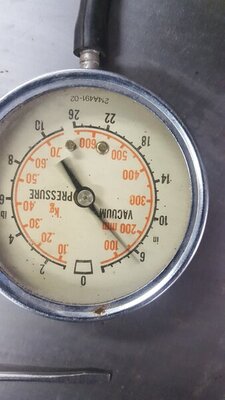Here is where my 284-484 mopar cam in at 108 idled with 18 initial, and 20 in the distributor. Geoff what vacuum can would fix this? More timing did nothing, and also how could it ever idle without more air added? I mean say 6" of vacuum vs 12" of vacuum do you not need a bigger restriction to get the same air. I did add about 10 degrees with the vac can at cruise speed, any more and it would miss, even with bigger idle feeds, just like the late engine did. Plugs were clean, pipes were grey inside, power brakes even worked, it ran pretty well got decent mileage, but was a 4-speed.
190 pounds compression within 5 pounds in every hole.
Mine does exactly the same, you can add timing till end of times...lol.
But the vacuum does not get better, well tell a lie..it does get better because idle rpm goes up as you are moving to the MBT point, lowering the idle speed gets you back at the same vacuum as before and throttle is still too far open. Mine was that far open that it was
always pulling vacuum on
ported vacuum (Holley 750 DP and 780 Street Avenger (vac sec) and both did the same thing. My cam has 238/244 @ .050" .572/.576" and 108 LSA, it does 283/291 @ .008" so the real duration is even longer than that. Some cam manufacturers also take advantage of the .904" lifters and have a higher rate of lift so it is not just duration, there is also more lift over longer time.
The engine requires the air as per it's displacement at idle, that volume cannot be given by the carb alone as it is too restrictive so commonly one adjusts the curb idle screw to open them more...and then the problems start. (
also keep in mind that due to the low vacuum there is poor fuel distribution and atomization as with high vacuum it shears the fuel when it passes the throttle blades.)
Idling pig rich, smoking, greasy plugs and the obvious stumble at some point.
The carb is too far open, not responding on the idle mixture screws and is rich as it is on the transition slot and when taking off it stumbles as you run out of transition slot before the boosters start flowing fuel, I had it all.
You need to get the carb to do its work on basic settings and let it provide what it can, add bypass air and provide the extra fuel with the idle mixture screws to enrichen the mixture.
Setting the carb back to basic idle settings and getting an alternative air source that you can control and find the point where it is running good.
I had a short piece of hose on the carb PCV port with a small plug with a hole in the center, I had 3-4 of them with different size hole and tried all. Fixed orifice.
After I got a Wagner PCV and set that to fixed orifice mode and now it has become an adjustable orifice.
When you go to far it will be same as when you have a vacuum leak so you are notified when you go to far.
After that you will find the idle mixture screws work and you set them accordingly.
From there on you will see where your idle is at, since you got the fuel and air sorted you can now make final idle adjustments.
- Increase rpm with more ignition advance. (yes a adjustable vac. can)
- Decrease rpm with air/fuel or retard ignition
This is how I got somewhere with mine, was a long road and lots learned!
Edit: I unfortunately found that using the vac. can just causes it to ping, a lot of vac. advance made it ping when driving off, a little vac. advance made it ping at light throttle to increase speed during driving.
18* initial and 18* mech advance, all in around 3000 and runs fine.
Now even better with Sniper Stealth EFI.
















